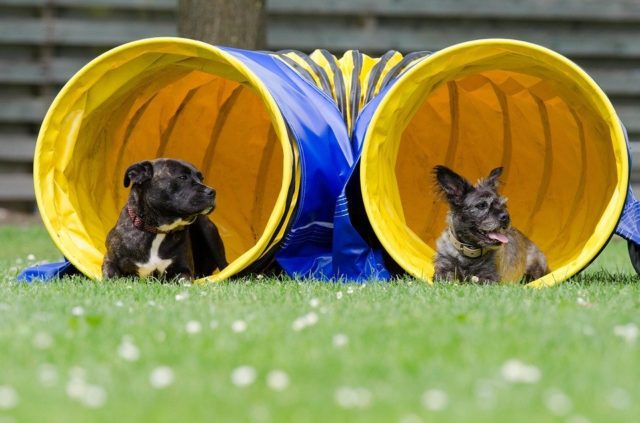Close Quarters: Avoiding Inter-Pet Aggression During Quarantine

With much of the nation under stay-at-home orders, cabin fever is at an all-time high. Cohabitating with our loved ones and furry friends provides many benefits, but being in close quarters for extended periods of time can be difficult—for humans and their animals.
Dr. Christine Rutter, a clinical assistant professor at the Texas A&M College of Veterinary Medicine & Biomedical Sciences, is an emergency and critical care specialist who has plenty of experience with dogs, both at work and at home. She talks about the challenges pets may face in the COVID-19 era and how owners can help by providing structure to their pets through routine.
“(In the Veterinary Medical Teaching Hospital) I’m seeing a different subset of emergencies because people are home,” Rutter said. “I’m seeing a lot of inter-pet aggression, such as big dog-little dog injuries or big dog-cat injuries; those kinds of things. Pets take their anxiety out the same way we do, which is on the people around us or on the pets around us.”
Just as humans have found the disruption of daily life to be stressful and upsetting, pets have also picked up on the change. Rutter says it is important to provide pets with a strong routine to minimize their stress and reduce the risk of inter-pet aggression.
One excellent outlet that can benefit both pet and owner is exercise.
“A walk provides a really important behavioral structure between an owner and a dog,” Rutter said. “It tells them, ‘I’m the leader; I’m taking care of you. You don’t have to be anxious about all of this, because I’m in control.’”
Walking two dogs together also can be beneficial in fostering a peaceful household because it teaches them to work together. Rutter compares this dynamic to working with a coworker you may not like—the encounter creates a shared cooperative experience.
Owners may also use their extra time at home to touch-up on their pet’s training, which can provide structure and enrichment.
“It’s a great time to start teaching your dog tricks. It may seem superfluous to teach your pet to sit, to heel, to stay, or to roll over, but it actually provides a really good way of communication,” Rutter said. “That’s a really solid way for your pet to know that they’re making you happy, which is kind of what a lot of them live for, right?”
If pets do begin to behave aggressively toward each other, Rutter recommends watching for raised hackles (the hair along the dog’s backbone standing up), mounting behavior, having their ears perked straight up, and other dominant-type behaviors. Confrontation can be prevented by separating the animals, by using a basket muzzle, or by removing factors that spark conflict.
“Feed your pets separately, have toys enjoyed separately, and remove those items from the environment whenever animals are together that have had conflict,” Rutter said. “If the pets have ever had conflict in the past, they are going to continue to do so, and so, no food items, no possessions, toys or anything like that; all those things need to be separate.”
Pet owners can also help by reducing stress within their household.
“As a general rule, things that would be stressful for a child are also going to be stressful for an animal,” Rutter said. “For example, raised voices, lots of chaos in the environment, changing routines, and having kids at home who wouldn’t normally be at home all the time.”
In extreme situations, aggressive pets may become dangerous to their humans and especially to small children who are unable to pick up on signs of aggression. Rutter recommends that pet owners review the American Veterinary Medical Association website on dog bite prevention to learn more about safe practices.
“Animal bites can be very serious, regardless of how they look on the surface, and always require urgent care by a physician,” Rutter said. “Identifying and avoiding opportunities for injuries to adults, children, and other pets is key.”
If pet owners have any concerns about their animal’s behavior, they should strongly consider reaching out to a board-certified veterinary behaviorist. These specialists have a unique set of skills that help them identify problem triggers and develop solutions for the whole household.
“Repeated, worsening, or dangerous situations are best handled through professional care,” Rutter said.
Though the current situation is stressful for everyone—person and pet—monitoring your animals for signs of inter-pet aggression while providing enrichment and routine to their daily lives can help your furry family stay happy until more normal circumstances return.
Pet Talk is a service of the College of Veterinary Medicine & Biomedical Sciences, Texas A&M University. Stories can be viewed on the web at vetmed.tamu.edu/news/pet-talk. Suggestions for future topics may be directed to editor@cvm.tamu.edu.


